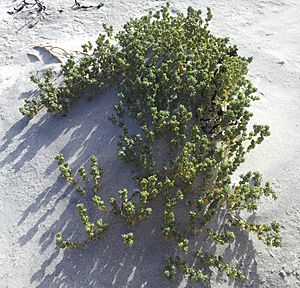Holloway's crystalwort facts for kids
Quick facts for kids Holloway's crystalwort |
|
|---|---|
 |
|
| Conservation status | |
 Nationally Critical (NZ TCS) |
|
| Scientific classification | |
| Genus: |
Atriplex
|
| Species: |
hollowayi
|
Holloway's crystalwort (Atriplex hollowayi) is a special type of plant found only in New Zealand. It's an annual herbaceous plant, which means it lives for just one year and has soft, green stems instead of woody ones. This unique plant is in big trouble! It's listed as "Nationally Critical" by the New Zealand Threat Classification System, meaning it's very close to disappearing forever.
What Does Holloway's Crystalwort Look Like?
Holloway's crystalwort is a soft and juicy plant. Its stems and leaves look like they are covered in tiny sugar crystals! This plant grows like a small, bushy shrub in sandy areas. It can spread out to be about 80 to 120 centimeters (about 3 to 4 feet) wide.
Its branches are yellow and can be 1 to 5 centimeters long. The leaves are smooth and shaped like an oval. They are small, usually 2 to 12 millimeters long and 1 to 6 millimeters wide. The edges of the leaves are not smooth; they have irregular, small teeth.
How Was This Plant Discovered?
Atriplex hollowayi was officially named in the year 2000. Two New Zealand botanists, Peter James de Lange and David Norton, described it. They realized it was different from another common plant called Atriplex billardierei.
While looking at old plant samples, Peter de Lange noticed two different kinds. One had bigger leaves and seeds. The other had smaller leaves with wavy, toothed edges and smaller seeds. This second type was only found in New Zealand's North Island. After more study, they named it a new species. They named it after John Stevenson Holloway, a botanist and conservationist who had passed away in 1999.
Where Does This Plant Live?
Holloway's crystalwort grows right on the strand line of beaches. This is the area of stable sand just above where the highest tides reach.
It used to be found on many beaches, from Northland all the way down to Wellington in New Zealand. Sadly, today it is only found on one single beach. Experts believe there are fewer than 50 plants left in the wild. No one knows for sure why its numbers have dropped so much.

